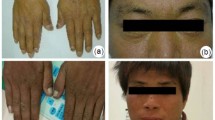Abstract
We investigated the molecular basis of ferrochelatase in a Japanese patient with erythropoietic protoporphyria (EPP), complicated by fatal liver failure, and defined a novel point mutation in the ferrochelatase gene. cDNAs were synthesized using Epstein-Barr-virus-transformed lymphoblastoid cells from the proband. cDNA clones encoding ferrochelatase in the proband were isolated by amplification using the polymerase chain reaction. There were two sizes of ferrochelatase cDNAs; one was normal in size, the other being smaller. Sequence analysis of the abnormally sized cDNA clones revealed that they lacked exon 9 of the ferrochelatase gene. Genomic DNA analysis demonstrated that the proband had the abnormal allele and that it contained a G to A point mutation at the first position of the donor site of intron 9. An identical mutation was detected in the affected family members of the proband by allele-specific oligonucleotide hybridization analysis. EPP is inherited in an autosomal dominant manner in this family.
Similar content being viewed by others
References
Bonkovsky HL, Schned AR (1986) Fatal liver failure in protoporphyria: synergism between ethanol excess and the genetic defect. Gastroenterology 90: 191–201
Brenner DA, Didier JM, Frasier F, Christensen SR, Evans GA, Daiely HA (1992) A molecular defect in human protoporphyria. Am J Hum Genet 50: 1203–1210
Chirgwin JM, Przybyla AE, MacDonald RJ, Rutter WJ (1979) Isolation of biologically active ribonucleic acid from sources enriched in ribonuclease. Biochemistry 18:5294–5299
Kappas A, Sassa S, Galbraith RA, Nordmann Y (1989) The porphyrias. In: Scriver CR, Beaudet AL, Sly WS, Valle D (eds) The metabolic basis of inherited disease, 6th edn. McGraw-Hill, New York, pp 1305–1365
Lamoril J, Boulechfar S, Verneuil H de, Grandchamp B, Nordmann Y, Deybach JC (1991) Human erythropoietic protoporphyria: two point mutations in the ferrochelatase gene. Biochem Biophys Res Commun 181:594–599
Magnus IA, Jarrett A, Prankert TAJ, Rimington C (1961) Erythropoietic protoporphyria: a new porphyria syndrome with solar urticaria due to protoporphyrinaemia. Lancet 11:448–451
Murasugi A, Takemori N, Hashimoto S (1987) Discrimination and quantitative analysis of wild type and point mutant early region 1B genes of adenovirus using oligodeoxyribonucleotide hybridization probes. J Biochem (Tokyo) 102:627–633
Nakahashi Y, Taketani S, Okuda M, Inoue K, Tokunaga R (1990) Molecular cloning and sequence analysis of cDNA encoding human ferrochelatase. Biochem Biophys Res Commun 173: 748–755
Nakahashi Y, Fujita H, Taketani S, Ishida N, Kappas A, Sassa S (1992) The molecular defect of ferrochelatase in a patient with erythropoietic protoporphyria. Proc Natl Acad Sci USA 89: 281–285
Padgett RA, Grabowski PJ, Konarska MM, Seiler S, Sharp PA (1986) Splicing of messenger RNA precursors. Annu Rev Biochem 55: 1119–1150
Robberson BL, Cote GJ, Berget SM (1990) Exon definition may facilitate splice site selection in RNAs with multiple exons. Mol Cell Biol 10:84–94
Rossi E, Costin KA, Garcia-Webb P (1988) Ferrochelatase activity in human lymphocytes, as quantified by a new high-performance liquid-chromatographic method. Clin Chem 34:2481–2485
Sambrook J, Fritsch EF, Maniatis T (1989) Molecular cloning: a laboratory manual, 2nd edn. Cold Spring Harbor Laboratory, Cold Spring Harbor, New York
Sanger F, Nicklen S, Coulson AR (1977) DNA sequencing with chain-terminating inhibitors. Proc Natl Acad Sci USA 74: 5463–5467
Sassa S, Fujita H, Doss M, Hassoun A, Verstraeten L, Mercelis R, Kappas A (1991) Hereditary hepatic porphyria due to homozygous δ-aminolevulinic acid dehydratase deficiency: studies in lymphocytes and erythrocytes. Eur J Clin Invest 21:244–248
Taketani S, Inazawa J, Nakahashi Y, Abe T, Tokunaga R (1992) Structure of the human ferrochelatase gene: exon/intron gene organization and location of the gene to chromosome 18. Eur J Biochem 205:217–222
Tutois S, Montagutelli X, Da Silva V, Jouault H, Rouyer-Fessard P, Leroy-Viard K, Guénet J-L, Nordmann Y, Beuzard Y, Deybach J-C (1991) Erythropoietic protoporphyria in the house mouse: a recessive inherited ferrochelatase deficiency with anemia, photosensitivity, and liver disease. J Clin Invest 88: 1730–1736
Author information
Authors and Affiliations
Rights and permissions
About this article
Cite this article
Nakahashi, Y., Miyazaki, H., Kadota, Y. et al. Molecular defect in human erythropoietic protoporphyria with fatal liver failure. Hum Genet 91, 303–306 (1993). https://doi.org/10.1007/BF00217346
Received:
Issue Date:
DOI: https://doi.org/10.1007/BF00217346




